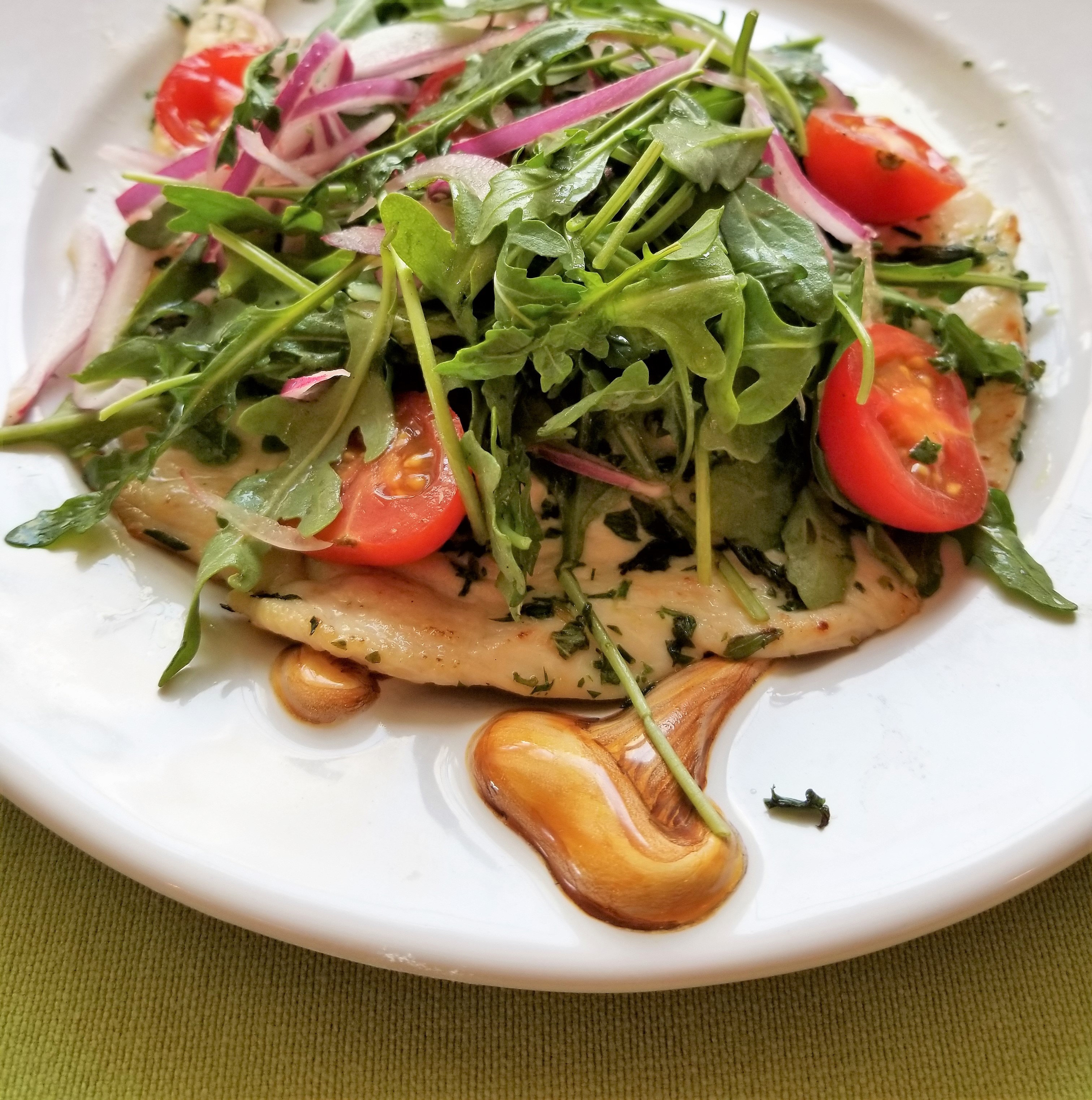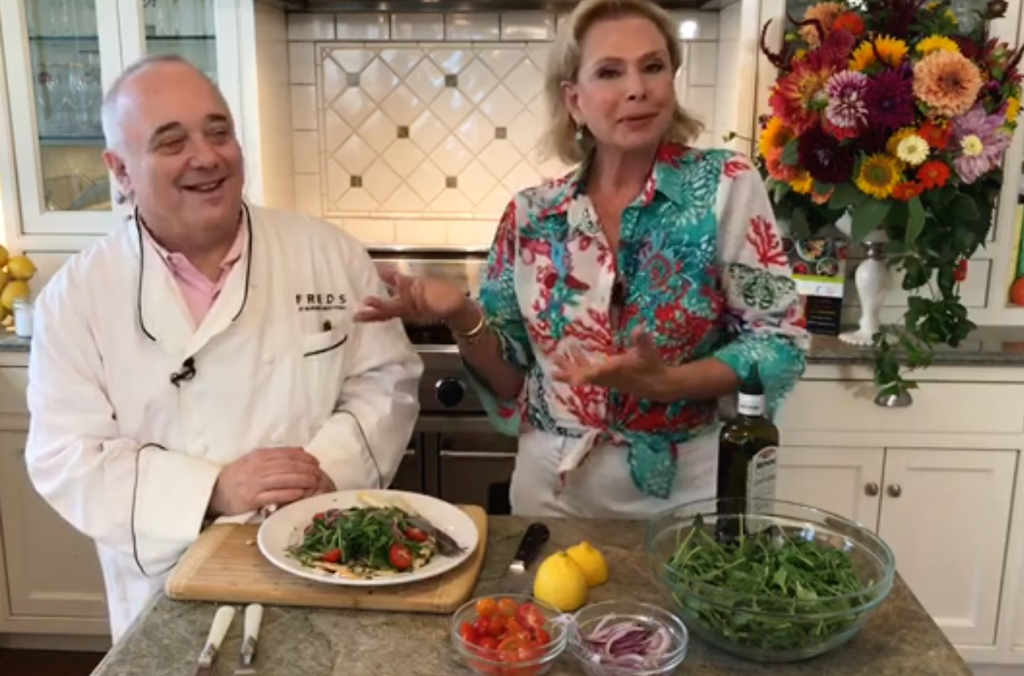The Perfect Paillards = The Perfect Lunch!
I can’t tell you how many times I’ve enjoyed the Chicken Paillards at Fred’s. It truly is the perfect lunch for any season! It’s packed with flavors from the herbs, it’s not too hot or cold, and it’s got lean protein that will fill you up without making you full!

Looks Like the Perfect Lunch to me!
The Man, the Master, The Mark Strausman
I had the pleasure of bringing a little bit of Barneys into my very own kitchen on the day that my friend and creator of the dish, Chef Mark Strausman came by to do a Facebook Live video with me. In the video he shares some of his tried and true techniques that make this dish so very special, which you can watch below. And if you want to make yours like the pros, you can pick up some Monini Olive Oil and Hamptons Sea Salt
Perfect your Pounding!
A master class in pounding meat from Mark’s book:
How to Pound a Paillard (Or Scallopine, Milanese, or Carpaccio)
This technique for pounding meat works whether you’re making a paillard, a Milanese (breaded paillard), or carpaccio (raw pounded steak–not a suitable way to serve chicken, obviously!). The goal is to end up with a piece of meat that is evenly thin all over.
Use a countertop where you have enough elbow room for leverage and that’s sturdy enough to stand up to pounding–we use a butcher block instead of the usual metal kitchen surfaces. Be sure to remove any objects that might fall off from the rattling as you pound. Place a very thick wooden cutting board (such as ones made by John Boos, which are widely available) on the surface to absorb the impact of the pounding. The best tool to use is a metal meat mallet/tenderizer, but they’re not all created equal. The best for home use is a solid stainless-steel round disc because it’s heavier and has a smaller center of weight than the more common square ones. It’s a bit small to do the volume that a restaurant requires, but it’s perfect for home use–or for beginnings. Use the flat side, not the scored one.
For each piece of chicken, tear off two equal size pieces of plastic wrap. Place one piece on the cutting board, lay the chicken on top, and drizzle 1 teaspoon of cold water over the chicken, which prevents it from sticking to the plastic. Lay the second piece of plastic on top. Now you’re ready to pound, but do so strategically by starting from the center. Part of the art is using the right force; too much will rip holes in the meat or plastic wrap. The time to exert a little extra pressure is not in the strike, but just as the mallet hits the meat. Rotate the piece (in the plastic) about 20 degrees clockwise after each strike, so you work your way around, and feel with your hand to make sure it’s evenly flat. From a 7-ounce chicken breast you should end up with a piece that’s about the size of a 10-inch plate. About halfway through pounding, lift the top layer of plastic and drizzle with a little olive oil so the plastic won’t tear the meat as you remove it for cooking. When the piece is fully pounded, remove the top plastic again, and drizzle with a little more olive oil and with herbs, if desired. Cover with the plastic and store flat in the fridge until you’re ready to cook it.

A complete Paillard from Strausman and Morgan!
This recipe includes two other signature Freds items, whose recipes can be found here:
Ingredients
Chicken Paillards
- 2 (7-ounce) boneless, skinless chicken breasts
- 2 tablespoons Freds Herb Mixture (see link in recipe notes)
- 2 Drizzle extra-virgin olive oil
Salad
- 2 cups baby arugula
- 10 cherry tomatoes, halved (or 2 plum tomatoes, quartered, seeds and center removed, then cut lengthwise into 1/4-inch strips)
- 4 (1/4-inch-thick) slices red onion
- 2 Kosher salt
- 2 Freshly ground black pepper
- 2 tablespoons Madison Avenue Dressing (see link in recipe notes)
- 1 lemon, halved, for garnish
Instructions
- Pound the paillards, in between sheets of plastic, according to the instructions above. Peel back the plastic, one side at a time, and sprinkle each paillard with a tablespoon of herb mizture and drizzle with olive oil. Keep refrigerated in the plastic wrap for up to 24 hours, until you're ready to cook.
- Place the arugula, tomatoes, and onion in a mixing bowl. Place the dressing close at hand but do not add to the salad yet.
- Unless you have two skillets, you'll need to cook the paillards one at a time. They cook quickly, so the first one will stay warm while you cook the second. Take one paillard out of the plastic wrap and sprinkle it on both sides with salt and pepper. Heat the skillet over medium heat until it's very hot. To check if it's ready, drizzle a drop of water into the pan. If it sizzles and balls up, the pan is ready. Briefly turn off the heat as you quickly remove the paillard from the plastic. Flip it into the hot pan, making sure it's flat in the pan, then turn the heat back to high. Cook until the top side starts to look cooked, and then use tongs to turn it over. If the paillard is very thin, turn off the heat, but leave it in the pan to finish cooking. If it's a bit thicker and needs more time, keep the heat on until the piece is firm, but do not overcook. Use a large spatula to transfer the paillard to an oversize dinner plate. Repeat with the second paillard.
- Quickly add the dressing to the salad, toss together, and then place in the center of each paillard. Garnish with half a lemon, and serve immediately.